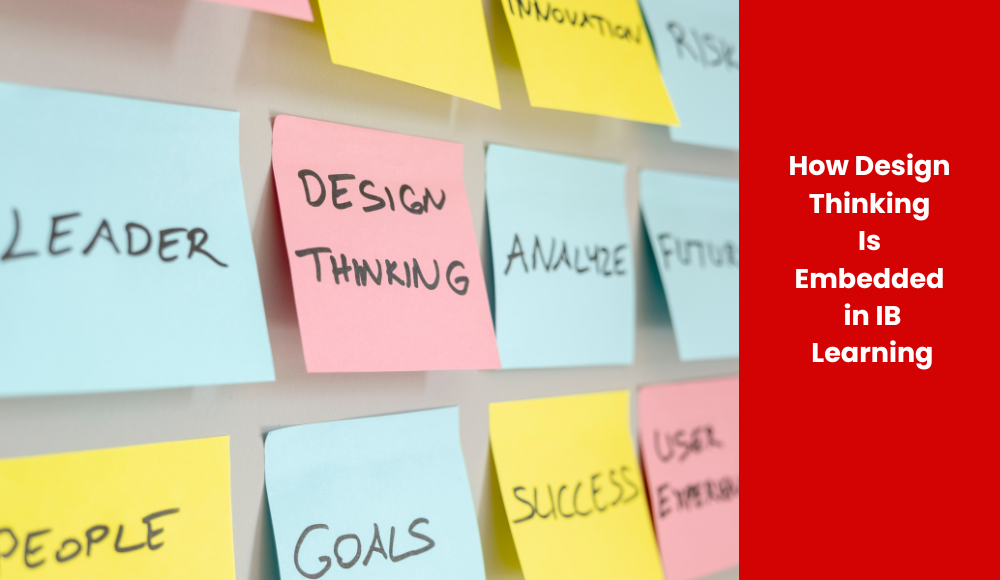How Design Thinking Is Embedded in IB Learning
In an increasingly complex world, the ability to think critically, creatively, and collaboratively is more important than ever. As educational paradigms evolve to meet the needs of the 21st century, frameworks like the International Baccalaureate (IB) have adopted cutting-edge methodologies that prepare students for future challenges. One of the most transformative approaches integrated into the IB curriculum is Design Thinking.
Design Thinking is a problem-solving framework that emphasizes empathy, creativity, and collaboration. It is a human-centered process that encourages students to define problems, generate innovative ideas, prototype solutions, and test those ideas in real-world settings. The inclusion of Design Thinking within the IB framework is an example of how progressive educational models foster skills that extend beyond the classroom and equip students with the tools to tackle real-world problems with innovation and empathy.
This article will explore how Design Thinking is embedded in IB learning, how it enhances the IB learner profile, and how it shapes the way students engage with their education and the world around them.
What is Design Thinking?
Design Thinking is a structured, yet flexible, approach to solving problems with a focus on human needs and a solutions-driven mindset. It involves several stages:
-
Empathize: Understanding the needs, challenges, and emotions of the people for whom you’re designing solutions.
-
Define: Clearly defining the problem based on insights gathered in the empathize stage.
-
Ideate: Brainstorming multiple solutions to the problem, encouraging creativity and out-of-the-box thinking.
-
Prototype: Developing simple, low-cost prototypes or models to test ideas in real-world situations.
-
Test: Testing the prototypes, collecting feedback, and iterating on the solutions based on real-world feedback.
In the context of the IB curriculum, Design Thinking provides a powerful tool that supports the holistic development of students, encouraging them to think critically, collaborate, and take ownership of their learning process.
How Design Thinking is Integrated into the IB Curriculum
Design Thinking is not just an isolated concept; it is embedded across various aspects of the IB framework, from the Primary Years Programme (PYP) to the Diploma Programme (DP). Here’s how it fits into each stage of the IB continuum:
1. Primary Years Programme (PYP)
In the PYP, the focus is on inquiry-based learning. Students explore significant, relevant questions that encourage deep thinking and understanding. Design Thinking is incorporated as part of the PYP’s inquiry cycle. Students begin with an inquiry into the needs and problems of their community or the world, moving through stages where they ideate, prototype, and test their solutions.
Example in PYP:
A unit on sustainability might involve students identifying environmental issues in their local community. They would first empathize with the people affected by these issues, then define the problem (e.g., waste management), brainstorm possible solutions, prototype a solution, and test it through action.
2. Middle Years Programme (MYP)
The MYP focuses on interdisciplinary learning, where students integrate knowledge from different subject areas to solve complex problems. Design Thinking is used to help students tackle challenges that require them to draw upon multiple disciplines and think critically about real-world problems.
Example in MYP:
Students working on a project related to social justice might use Design Thinking to develop a campaign to raise awareness about a social issue. They would empathize with the community, define the core issues, ideate solutions, create prototypes of their campaign materials, and test their campaign with real audiences to gather feedback.
3. Diploma Programme (DP)
In the DP, students are expected to engage in independent research, write extended essays, and conduct rigorous investigations. Design Thinking is especially relevant in the Creativity, Activity, Service (CAS) component of the DP, where students undertake projects that require them to identify community needs, create innovative solutions, and reflect on their actions.
Example in DP:
A DP student might use Design Thinking in their CAS project to develop a new educational tool for underprivileged children. They would empathize with the students’ learning needs, define the challenges they face, ideate potential educational tools, prototype those tools, and test them in real-world classrooms.
Key Benefits of Integrating Design Thinking in IB Learning
Design Thinking offers a wealth of benefits that directly align with the goals of the IB framework. Here are some of the key advantages:
1. Promotes Inquiry and Critical Thinking
Design Thinking enhances the inquiry-based learning approach at the core of the IB curriculum. By focusing on the empathize and define stages, students are encouraged to deeply understand problems before jumping to solutions. This promotes a culture of critical thinking and thoughtful reflection, ensuring that students ask the right questions and approach problems from multiple angles.
2. Encourages Creativity and Innovation
Design Thinking allows students to explore out-of-the-box solutions. Through the ideate stage, students are encouraged to think creatively and propose innovative solutions to problems. The focus on prototyping and iteration ensures that creativity is not only valued but also tested and refined through feedback and real-world application.
3. Fosters Collaboration and Communication
Design Thinking thrives in collaborative environments. Students work together in teams, sharing ideas, debating solutions, and combining their diverse perspectives to come up with the best possible outcomes. This collaborative nature of Design Thinking aligns perfectly with the IB’s emphasis on international-mindedness and teamwork.
4. Develops Empathy and Global Awareness
At the heart of Design Thinking is empathy—understanding the needs, emotions, and perspectives of others. The empathize stage encourages students to consider different viewpoints and become more globally aware. This aligns with the IB’s learner profile, which emphasizes being caring and open-minded.
5. Builds Problem-Solving Skills
Design Thinking equips students with a problem-solving mindset, teaching them to break down complex challenges into manageable components. By tackling real-world problems, students learn to approach issues with a solution-oriented mindset, which is critical for success in both academic and personal contexts.
6. Supports the Development of Soft Skills
Beyond academic skills, Design Thinking nurtures soft skills such as collaboration, communication, adaptability, and resilience. These are essential traits for students who will need to navigate an increasingly complex, interconnected world. The iterative process of prototyping and testing fosters an ability to cope with failure and learn from mistakes, which is a valuable lesson for any young learner.
Design Thinking and the IB Learner Profile
The IB Learner Profile consists of 10 attributes that define the ideal IB student: inquirers, knowledgeable, thinkers, communicators, principled, open-minded, caring, risk-takers, balanced, and reflective. Design Thinking naturally aligns with many of these attributes:
-
Inquirers: Through the empathy and define stages, students learn to ask important questions and seek meaningful answers.
-
Thinkers: The ideate and prototype stages challenge students to think critically and develop creative solutions.
-
Communicators: Students must collaborate and share ideas, making effective communication a key aspect of Design Thinking.
-
Risk-Takers: The prototyping stage encourages students to take risks by testing their ideas in the real world.
-
Reflective: The test and iterate stages require students to reflect on their work, gather feedback, and improve their solutions.
By engaging in the Design Thinking process, students develop the traits of the IB Learner Profile in a holistic and practical way, ensuring they are well-prepared for the challenges of tomorrow.
Conclusion: The Future of Learning with Design Thinking in IB
Design Thinking offers a powerful framework for preparing students to face the challenges of an ever-evolving world. By embedding Design Thinking into the IB curriculum, schools provide students with the tools to think critically, innovate, collaborate, and empathize with others. These skills are essential not only for academic success but also for personal growth and leadership in the real world.
As the world continues to change, the ability to think like a designer—to approach problems with empathy, creativity, and collaboration—will be an invaluable asset for students. By integrating Design Thinking into IB learning, schools like K.R. Mangalam Global School, GK1 are helping to create a generation of global citizens who are prepared to tackle the world’s most pressing issues with innovative solutions and thoughtful leadership.


